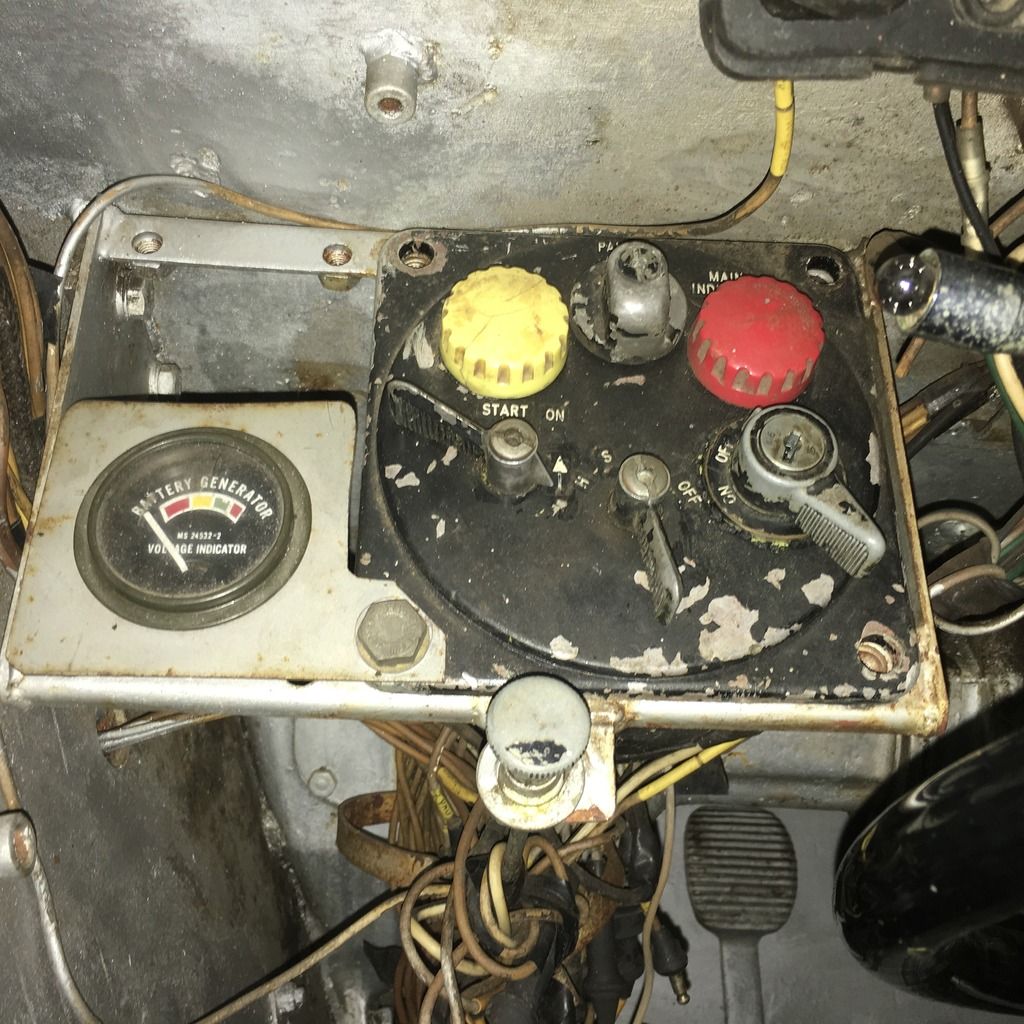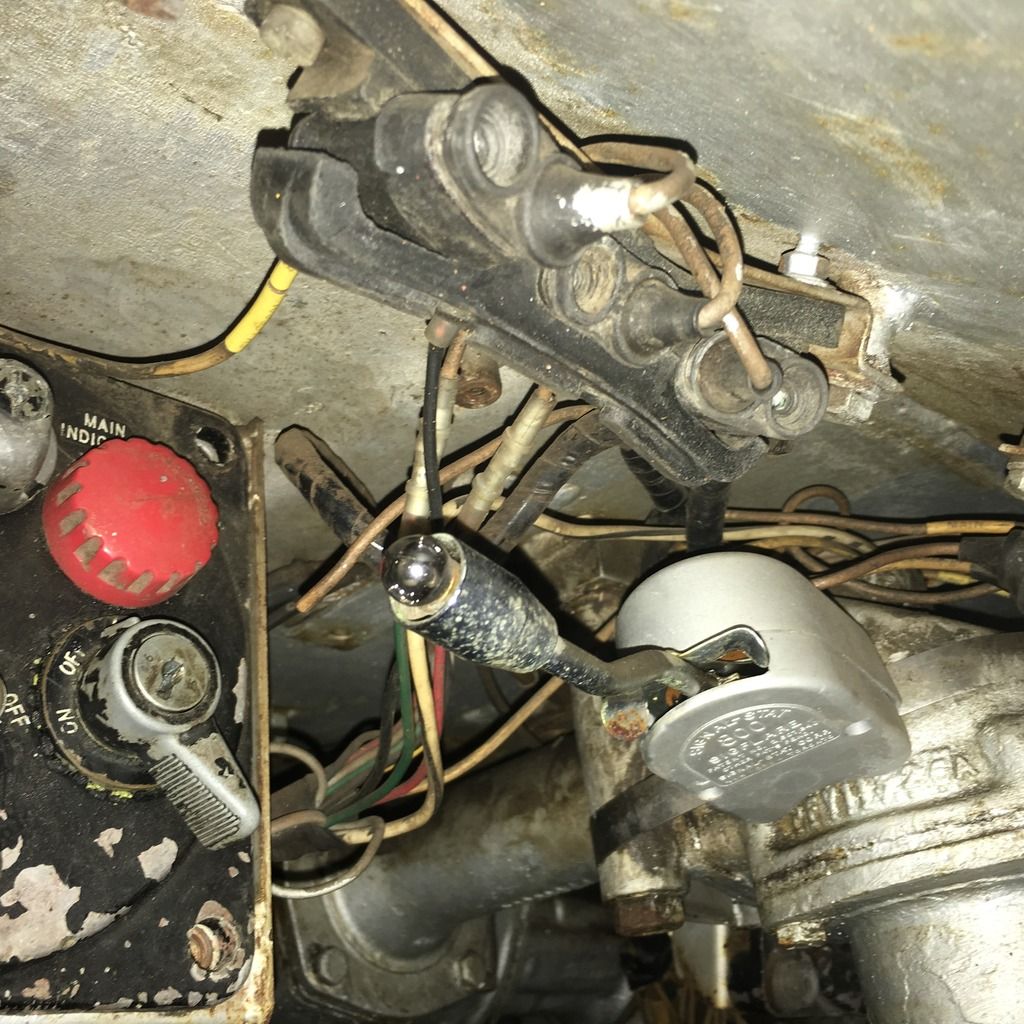
 |
|
#1
|
|||
|
|||
|
We have some Canadian Ferrets here that were converted to alternators in the 1970's or '80's. The conversion included disconnecting the original "P" wire. This supplied voltage to the original field winding through the 6W charging bulb on the switchboard so the light went out when the generator was charging.
It replaced the "P" wire connection to the alternator field winding with the "R" wire, which is ignition-switched 24V. This meant the charging light no longer worked so I assume the voltmeter was added to show the charging state. I recently bench-tested a couple of alternators. Instead of using +24V to excite the field windings (equivalent of the "R" wire), I used a test light connected between battery +24V and the field winding, which is equivalent to the P wire (although I don't know the wattage of the test light bulb). I spun the alternator with a drill. It loaded up and generated 15A charge at only 1200 rpm and the test light dimmed as the voltage across it equalized. I assume it would have gone out if I could have spun the alternator as fast as the engine would at idle. So I'm curious why the conversion used the "R" wire rather than the "P" wire which seems to work and would have kept the charging light working. Malcolm Last edited by Malcolm Towrie; 03-10-16 at 07:39. |
|
#2
|
|||
|
|||
|
I converted a FV432 to the US type alternator (2920-00-909-2483) and, in error, used a wire that was not full voltage but rather went through a resistor. The alternator would overcharge, and could not be set (there is a small potentiometer on most of them to set the max voltage) so as not to. So the alternator is sensitive to the field wire's voltage. You would have to try it on the ferret to find out if it causes overcharging.
In Canadian service, there was a CFTO to install that alternator on just about everything (3/4 ton, deuce, 5 ton) with the earlier 25 amp systems as well as the ferret with it's British system. I always found them to be a reliable alternator and an easy conversion. |
|
#3
|
|||
|
|||
|
Quote:
Malcolm |
|
#4
|
|||
|
|||
|
If the Cdn forces wanted a light, then there would have been a light. They wanted a gauge so you have a gauge.
The alternator is capable of putting out over twice the amperage of the British system, and was almost a drop in to the British vehicles. How could one ask for more? If you really wanted the light, many of those alternators have an extra terminal hidden under their covers. It puts out AC voltage, and in the case of the MLVW, they use that AC to supply the electric tachometer. Perhaps, with a diode and a relay you could have the light working. But then you are starting to re-create the Iltis, with gauges and matching idiot lights. |
|
#5
|
|||
|
|||
|
That's the thing, we don't have gauges. Of the 3 Ferrets I have fixed up here, not one has a gauge installed despite all having an alternator. Not even the gauge mounting plate.
To further confuse me, the 4th Ferret I have worked on, which is on permanent loan from a private collector and has been restored, it has the gauge, but it also has the light wired in somehow and it never goes out despite the gauge showing good charging! So I've removed the bulb. I'm not hung on the light at all, gauges are good. I'll need to track down 3 gauges and mounting plates. Malcolm |
|
#6
|
|||
|
|||
|
It is a very common gauge, still used today on a few military vehicles. Mind you, in Cdn service, much less vehicle types than they used to be.
I don't recall now, it having been a few years since reading the instruction, but was the bracket for the gauge manufactured as part of the modification ? |
|
#7
|
|||
|
|||
|
I don't know, I don't have the instruction.
I'll check out our various Ferret part stashes here for gauges and plates. Not a high priority though since as you say these alternators are reliable and we have a couple of good spares to replace the bad one we found in one Ferret. |
|
#8
|
|||
|
|||
|
The gauge was the same one used on the later Jeeps, the M151A2, the deuce and a half, the 5 tons, the MLVW, the M113 family, the M109.....the list is endless.
|
|
#9
|
|||
|
|||
|
Some photos I took of my Ferret for reference. This is how I received it. If there is something more specific you need to see I can take some photos for you. Gauges are easy to find, on Epay all the time. Not much to the bracket.
Hope these help a bit.   [/URL] [/URL]
|
|
#10
|
|||
|
|||
|
Brad
Long time no hear. Ebay also has the little green lens for the end of the turn signal arm. http://www.ebay.com/itm/OLD-Vintage-...2OaTCQ&vxp=mtr |
|
#11
|
||||
|
||||
|
Malcolm as far as the British conversion using Generator No.10 goes the P & R connections are shown on page 64 of this
http://hmvf.co.uk/forumvb/showthread...Latest-Version
__________________
Clive Elliott GW4MBS (Old) South Wales UK |
|
#12
|
|||
|
|||
|
I found one voltmeter and panel so I'll hook it up and confirm it works.
Clive, the Canadian alternator upgrade did away with the generator panel. The alternator is wired with one light wire for field excitation and one heavy charging wire. I'm puzzled again. A member kindly sent me the 20 page Canadian Forces installation instructions for this modification. It's very badly written IMO, but it does have a wiring diagram that clearly shows the P wire from the charge light on the switch panel going to the field winding connection on the alternator. I have tried this and can't get it to work. The alternator overcharges badly using the P wire. As I mentioned in the posts above, the modified Ferrets we have all use the R wire, so I'll stick with that. Malcolm |
 |
|
|
 Similar Threads
Similar Threads
|
||||
| Thread | Thread Starter | Forum | Replies | Last Post |
| Ferret, a question of morality or reality check | Robin Craig | Post-war Military Vehicles | 11 | 01-12-15 20:12 |
| One more Ferret Gear-Box/Transfer-Case question..... | Chris Preston | The Restoration Forum | 7 | 11-06-15 09:25 |
| Another Ferret (fuel tank) question.......... | Chris Preston | The Restoration Forum | 2 | 30-05-15 23:03 |
| Canadian Ferret bracket question | Robin Craig | Post-war Military Vehicles | 4 | 10-04-15 02:32 |
| Marking on Ferret question | Bruce Parker (RIP) | The Armour Forum | 8 | 12-12-11 11:14 |